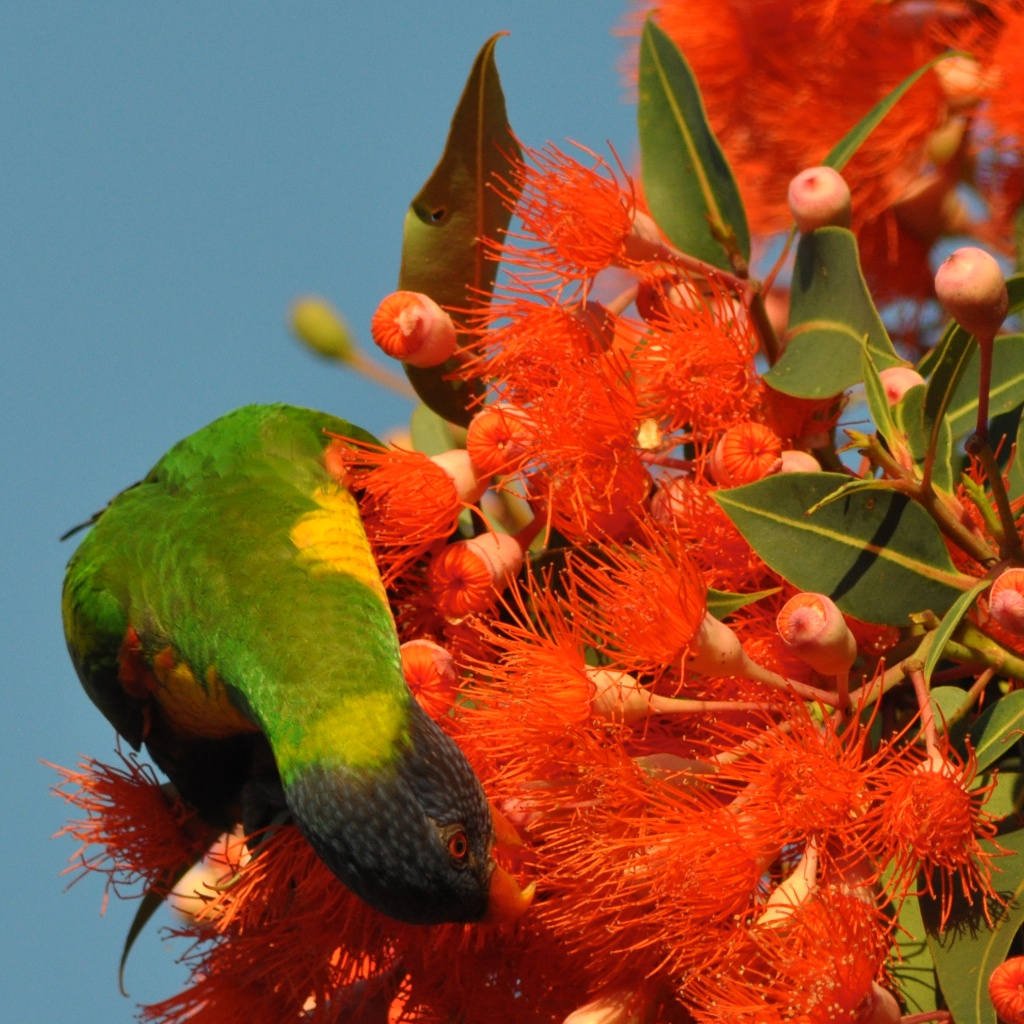 |
 |
 |
 |
 |
 |
 |
 |
 |
 |
 |
| Last Updated: Thu Jul 14 11:51:52 UTC 2016 |
 |
 |
 |
 |
 |
 |
 |
 |
 |
 |
 |
| Last Updated: Thu Jul 14 11:51:52 UTC 2016 |
| Australian Suburban Wildlife (Page
IV) |
 |
|
Mundane as Australian suburbia might be, we often do get interesting visitors. This multi-part web page contains a selection of recent suburban wildlife pictures of interest. Photos and text ¿
1997-2012 Carlo
Kopp; Photographs produced using a Fuji S5600 5.1 MP, Fuji S5800 8.0
MP, Fuji HS10 10.3 MP, Nikon D90 12.3 MP and Mamiya 645/1000S.
|
 Rainbow
Lorikeet foraging for nectar in a suburban eucalypt tree in Noble Park (Image ¿ 2011 Carlo
Kopp; Nikkor 70-300mm f/4-5.6D
ED / D90).
|
|
“Native Bird Friendly” Backyards |
|
The numerically dominant
bird
species in most Australian suburbs are imported pests, such as the House Sparrow, European Blackbird, Indian Mynah and Spotted Turtle Dove. These species
forage in the suburbs and can be often observed feeding on leftover or
unattended pet food - Turtle Doves
are especially fond of dry petfood pellets.
Australian native birds common in Melbourne suburbs include Magpies, numerous parrot species, especially Lorikeets, Wattlebirds and in some areas, other honeyeaters, and Kookaburras or Kingfishers. While Magpies and Kookaburras are scavengers with a taste for leftover or unattended pet food, many parrots and honeyeater species are far more selective in their dietary needs. Flowering native trees and shrubs are the primary food supply for these species in the wild, and planting these in suburban backyards creates a much friendlier habitat. Native species which are
often
planted to support native birds include various Banksias, Eucalypts and
Grevilleas. Where domestic or feral cats are present, it is a good
practice to remove cover and trim away lower branches - a large
cat breed like a Maine Coon can jump to a height in excess of 6 feet
when hunting birds - I observed a large Raven come within 250
milliseconds of becoming catfood in exactly this manner.
 Red Wattlebird prior to feeding on a Banksia Integrifolia. This loud native honeyeater is a frequent visitor in Melbourne suburbs, but mostly prefers native blossoms (Nikkor 70-300mm D-ED/ D90 08/2011).  Red
Wattlebird feeding on a Banksia Integrifolia
(Nikkor 70-300mm f/4-5.6D-ED/ D90 03/2012).
  |
 Rainbow Lorikeet feeding on a Banksia Integrifolia (Nikkor 70-300mm f/4-5.6D-ED/ D90 03/2012).   |
 The Banksia integrifolia or Coast Banksia is indigenous across
the southern Australian coastline and thrives even in very poor soils
with modest or poor water supply, making it well suited for Melbourne
suburbs. The species is available at low cost, grows quickly and its
distinctive blossoms are well liked by honeyeaters (03/2010).
 Immature Banksia integrifolia blossom
(Sekor C 105-210mm f/4.5 ULD Macro #2 / D90).
 Mature
Banksia integrifolia blossom (Above, below Fuji S5800).
  Immature Banksia integrifolia blossom (Nikkor 35mm f/1.8G DX / D90).
 Banksia integrifolia seed pod (Nikkor 50mm f/1.8D / D90). |
 The Banksia spinulosa shrub produces
large nectar rich blossoms. This image shows immature spikes next to
the previous season's flower. The species is indigenous to Eastern
Australian coastal regions (03/2010).
   Mature Banksia spinulosa blossom (M645/1000S
using
Sekor
C
105 - 210 mm ULD zoom, 3-S macro extender and Fuji Pro
800Z).
|
 Mature Banksia spinulosa blossom, red form
(Nikkor 35mm
f/1.8G DX ISO 400 1/60 / D90).
 Mature Banksia spinulosa blossom, red form
(Tokina
20-35mm f/2.8 ATX Pro / D90).
|
 Brush
Wattlebird feeding on
blossoms of the Grevillea banksii (03/2012).
  |
 The
attractive
native Grevillea banksii
bush is popular in Australian gardens, and is a favourite with numerous
native bird species. This example has fed Brush Wattlebirds, Red
Wattlebirds, and a transient New
Holland Honeyeater (Tokina 20-35mm f/2.8 ATX Pro / D90).
 Grevillea banksii
blossom (Sekor C 105 - 210 mm ULD zoom, M645/1000S
using 3-S macro
extender and Fuji Pro 800Z).
 Grevillea banksii
blossom (Sekor C 105 - 210 mm ULD zoom, using 2-S
macro
extender / D90).
 Grevillea banksii blossom (Nikkor 35mm f/1.8G DX / D90). |
|
Rainbow
Lorikeet foraging for nectar in a suburban eucalypt tree in Noble Park (Image ¿ 2011 Carlo
Kopp; Nikkor 70-300mm f/4-5.6D
ED / D90).
|
 The Eucalyptus caesia
or Silver
Princess is a small gum tree indigenous to the wheatbelt of my
home state, Western Australia. It is well suited to suburbia as it is
small but grows quickly, but is like many Eucalypts maintenance
intensive as its characteristic drooping branches fracture
easily. This example is the red flowering subspecies, about five
years of age - it has fed Brush Wattlebirds, Red
Wattlebirds, and Rainbow Lorikeets (03/2010).
    Eucalyptus caesia
blossoms (Nikkor 50mm f/1.8D / D90).
  Eucalyptus caesia
blossoms (D90 /
35mm f/1.8G DX ISO 800 1/800).
|
 Eucalypt blossoms, pink, above
budding, below fully developed (D90 /
35mm f/1.8G DX ISO 220 1/60).
|
 European fruit trees often provide
seasonal sustenance for native nectar feeding birds. Depicted a pair of
Rainbow
Lorikeets foraging in Noble Park (09/2007).
  A European Honey Bee
feeding on a
plum blossom - note the deployed proboscis as it alights. These are
resized crops from a sequence of over 60 frames captured using
Continous Mode exposure in the D90 - most were successful. Distance is
~5 feet @ 300 mm and f/8.0, i.e. this is not macro photography (Nikkor
70-300mm f/4-5.6D-ED/ D90 08/2011).
    European Honey Bees feeding on a
Coastal
Banksia, and a lemon tree blossom (Nikkor 50mm f/1.8D /
D90 06/2012).
  Ornamental plum tree blossoms in Noble Park area (30/08/2007).    A Brush Wattlebird perched on a folded dipole VHF antenna. This species is unusually loud for its size (03/2010). |
|
|
| Other
Interesting
Wildlife
Sites http://www.wildlife-photo.org/  |
|
|||||||||||||||
| Artwork and text ¿ 1994 - 2010 Carlo Kopp; All rights reserved. |
| $Revision: 2.279 $ |